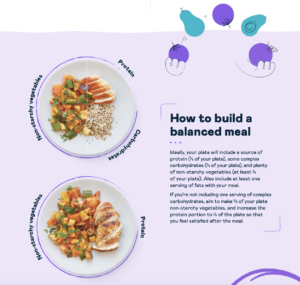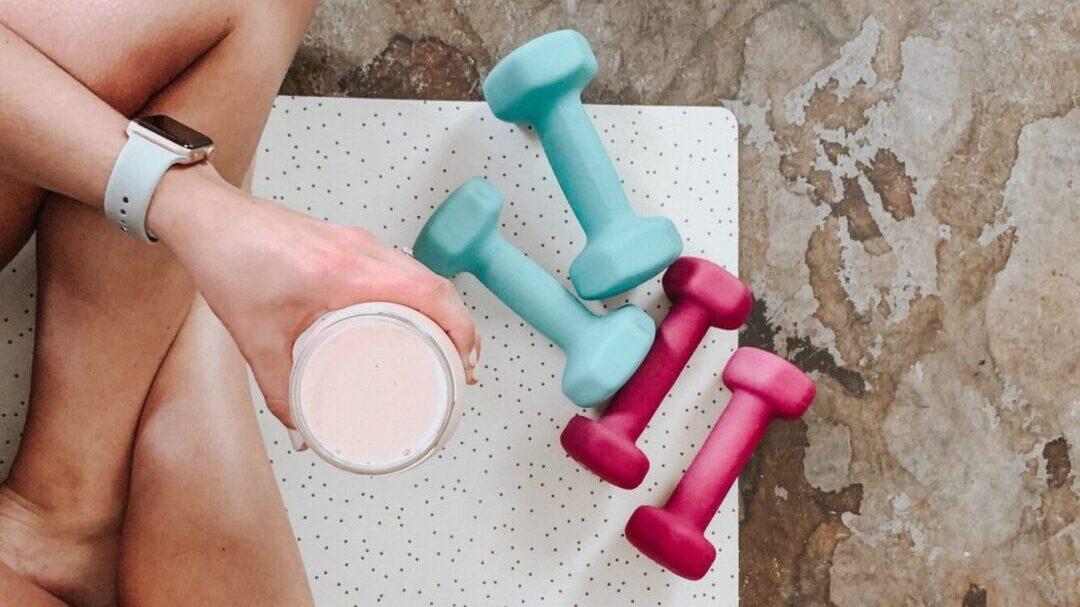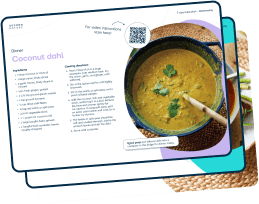Jump to: Eat enough protein | Resistance (strength) training | Make sure you eat enough | Get enough sleep | Take home message
To lose fat without losing muscle, ensure adequate protein intake, try resistance (strength) training, ensure you’re eating enough, and get enough sleep.
Here are some tips to help in these four areas:
1 – Eat enough protein: The amount of protein you eat is critical to successful weight loss. Aim for 20-40 grams of protein in each of your main meals; this includes breakfast. Great sources include yoghurt, other dairy products, eggs, meat, fish, seafood, tofu, and tempeh.
2 – Resistance (strength) training: If you want to try and join a gym, great, but you don’t need to and can get all the benefits of strength training from the comfort of your home. Try and snack on exercise throughout the day to kickstart your resistance training habit by doing push-ups while the kettle boils and squats whilst you cook.
3 – Make sure you eat enough: Crash diets lead to a starvation response by your brain, which may see your body breaking down lean tissue to provide an energy source as it tries to protect your fat stores. A calorie deficit of around 10% and eating a diet based on whole foods can help you lose weight sustainably without losing excess lean tissue.
4 – Get enough sleep: Aim for 7-9 hours a night. Have a regular sleep schedule, avoid caffeine after midday, and screens 30 minutes before bedtime.
Why do we need to protect our lean mass?
Your lean tissues and body composition are crucial to maintain and grow to achieve optimum health.
Research has suggested that the more lean mass you have – as a relative percentage of your total body weight – the healthier you are and the longer you’re likely to live.
Your lean mass comprises your bones, muscles, organs, and vital tissues, which require sufficient energy to maintain and function. They’re very metabolically active tissues and a big part of your total energy expenditure.
The rest of our body is composed of our fat mass, and while being very important to our health, it’s much less metabolically active and becomes dysfunctional when we have too much.
Interestingly, it’s not just about how much lean mass you have but how functional it is.
A study investigating the link between strength, muscle mass, and all-cause mortality showed that while low muscle mass increased your relative risk of dying of all causes by 40%, low strength was associated with a 134% increase in the risk of death compared to those with high strength.
Why do strength and lean mass matter?
Imagine an airport. You’ve got your check-in staff, the security, the gates, and the planes. This whole system works when everything is kept moving. People come in, wait in the right areas, and then leave.
If there’s a blockade at any stage of the process, from your arrival at the airport to your getting on the plane, it can cause delays which have a ripple effect on the functionality of the rest of the airport.
Your body is very similar in this respect and how it wants to manage energy. Your body wants to keep energy moving into where it needs to be burnt and put some aside for later use.
The stronger you are and more lean mass you have, the greater your body can keep the energy moving in and out of the cells where it’s burnt and stored. Much like an airport’s ability to keep passengers moving will define its efficiency.
A high amount of lean mass with increased strength will help your body keep energy in this state of flux, constantly moving into usage and storage.
In comparison, having more fat mass can result in your body having to work harder to maintain these larger fat stores and its ability to keep energy in flux decreases.
So, prioritising your lean mass and strength alongside your weight loss will help you achieve better health in the long term and improve your chances of keeping the weight off for good.
At Second Nature, you’re supported by a registered dietitian or nutritionist who can personalise your intake and activity to your goals and preferences.
We have an exercise toolbox filled with videos and the most up-to-date scientific evidence on improving your strength and building muscle.
If you’d like to join over 150,000 others who’ve lost weight, retained their lean mass, and improved their health for the long term, click here to take our health quiz.
Otherwise, keep reading as we look deeper into the science of maintaining and growing your lean mass during a weight loss journey.
1) Eat enough protein
Protein is your body’s key ingredient in building new tissues, like muscle and bone.
Technically speaking, it’s the combination of essential amino acids (think of them as individual proteins) that protein is composed of that the body will break down and utilise where they’re needed.
When you eat, you’re constantly sending a signal to your brain about what it can do with what you’re giving to it; food is information, and protein is no exception.
The amount and quality of the protein you’re consuming are vital for the brain to commit the energy and resources needed to build and maintain tissues.
Your body needs to know that you’re consuming enough essential amino acids to trigger the events needed for growth and maintenance.
Research consistently shows that higher protein intake can help you maintain lean mass during a weight loss journey.
A human clinical trial placed 46 women on a calorie deficit of 1750 calories per day for 12 weeks. They were then split into two and instructed to consume 30% of their energy from protein or 18%.
After 12 weeks, both groups lost weight and some lean mass. However, the lower protein group lost 46% more lean mass than the higher protein group.
Interestingly, the study also reported that individuals on the higher protein diet were less hungry and more satisfied with their diet during the intervention.
Alongside this individual trial, higher protein intake during weight loss is now well-established in the literature and has been repeated across different cohorts of individuals in multiple settings.
A systematic review and meta-analysis (a trial comparing lots of trials on one subject) reviewed 20 randomised controlled trials investigating the impact of higher protein (>25%) and lower protein (<25%) on lean mass retention during weight loss.
The study concluded that individuals following higher protein diets retained lean mass and lost more fat mass during weight loss interventions.
This effect on fat mass might be due to protein’s satiety benefits. Less hunger might result in you eating less overall and losing more fat.
Additionally, protein has a higher thermic effect than carbohydrates or fat, so your body needs to burn more energy during digestion and metabolism.
At every meal, we’d recommend ensuring around 25-30% of your plate contains a high-quality source of protein like:
- Meat
- Tofu
- Fish
- Seafood
- Yoghurt
- Cottage cheese
- Lean cheeses
- Tempeh
- Meat alternatives
- Protein powders (in the recommended amounts)

Key points:
- Protein is the key ingredient for your body’s tissues.
- Higher protein intake has been shown to support lean mass retention during weight loss, compared to lower protein intake.
- Interestingly, individuals following higher protein diets tend to have lower hunger, with some studies also showing higher meal satisfaction.
- Higher protein intake may also support individuals to lose more fat mass due to increased satiety and its thermic effect.
2) Resistance (strength) training
We described above how protein intake signals the body and brain and that food is information to allow the brain to determine how to respond and whether to grow new tissues.
Resistance training and exercise are the same. It’s the most potent signal we have to instruct the brain to retain and grow new tissues, such as bone and muscle.
Research has shown that exercise and resistance training can be an effective way of retaining lean muscle mass or even aiding muscle growth during weight loss.
A randomised controlled trial in 141 participants investigated the impact of three exercise interventions – cardio, resistance training, or a combination of both – alongside a weight loss diet to determine its effect on physical performance, lean mass, and bone mineral density.
The study showed that all three groups lost an average of 9% of total body weight. However, the resistance and combination group lost less lean mass than the cardio group (2% & 3% vs 5%) and less bone mineral density in the hip (0.5% & 1% vs 3%).
This suggests that resistance training or a combination of resistance training with cardio training is the most effective exercise intervention to support lean mass retention during weight loss.
A recent systematic review and meta-analysis that reviewed 45 studies with 3,566 participants supported these findings.
The authors concluded, ‘Interventions that combine high intensity aerobic and high load resistance training exert beneficial effects that are superior to any other exercise modality [the type of exercise] at decreasing abdominal adiposity [the fat stored in your trunk], improving lean body mass’.
How to make exercise a habit
The difficulty with exercise often comes in introducing it into your routine and keeping up with it.
Here are our top tips for making exercise a habit:
- Start small and build: Your brain needs to develop new communication pathways to cement exercise as a habit in your routine. Trying to do too much too soon can be overwhelming. If you start small, you’ll give your brain time to learn, and you’re more likely to be successful.
- Identify your intrinsic motivation: Why is exercise important to you? Reflect on why being physically fit and active can benefit you emotionally and psychologically; this will help you stay motivated and progress.
- Find a community: Going at it alone can make change difficult. Research has shown that you’re more likely to maintain a habit if there’s a social element to it. Join a gym, get a personal trainer, join a local class, or pull together some friends to work out in the park once a week.
Key points:
- Resistance and weight training is the most potent signal to the brain to maintain and build muscle, particularly during weight loss.
- To make exercise a habit you should start small, identify your intrinsic (internal) motivation, and find a community to make it social and add a layer of accountability.
- You don’t need to join a gym or lift heavy weights to benefit from strength training and avoid muscle loss, there are many other options.
- Combining resistance training and weight lifting with high-intensity interval training and cardio would be the best workout routine to get maximum health benefits.
3) Eat enough
Severe calorie deficits are often the go-to approach when individuals are looking to lose weight.
Severe calorie restriction does lead to rapid weight loss (primarily through depletion of glycogen and water weight initially). Still, one of the downsides is that you tend to lose more lean tissue during this process.
When you go on a crash diet, your brain picks up on the lack of incoming energy and initiates a starvation response.
This response signals the body to slow down its metabolism and conserve as much fat tissue as possible. Along the way, this can lead to your body breaking down lean tissues, such as your bone and muscle, to fuel your energy needs.
This is because your body associates the amount of fat you have stored with your ability to survive during a famine. So, if you’re signalling a lack of energy, it will react by conserving its fat stores and sacrificing some lean tissue.
However, research has shown that if you don’t restrict your calorie intake so dramatically and lose weight more sustainably, you’ll be able to mitigate much of the lean mass losses seen in strict crash diets.
A randomised controlled trial in 101 women living with obesity compared the effects of a severe caloric restriction (30% calorie deficit) to moderate caloric restriction (10% calorie deficit) to determine their impact on weight loss and loss of lean mass.
After 12 months, the severe caloric restriction group lost twice as much weight as the moderate group. However, they also lost 1.5 times more whole-body lean mass and 2.5 times more bone mineral density in the hip.
Interestingly, a similar study in elite athletes compared a slow-rate weight loss diet (19% calorie deficit) to a fast-rate (30%) to determine its impact on lean mass retention during weight loss while they continued their training.
The study showed that the fast-rate group maintained their lean mass after four weeks. In comparison, the slow-rate group increased their lean mass by 2%.
How can you eat enough?
We recommend that you avoid counting calories, as this can often lead to an obsessive approach to weight loss.
We also recommend you eat a high-protein diet based on whole foods and eat until you’re comfortably full,
If you’d like to try a weight loss diet that will give your body everything it needs and help you retain your lean mass, click here to join over 5,000 monthly visitors and try our NHS-trusted 7-day meal plan.
Key points:
- Crash diets and eating fewer calories lead to more dramatic weight loss in the short term, but this often comes at the cost of more lean mass losses.
- Studies show that if you eat a more moderate calorie deficit during weight loss, you can lower your body fat percentage and mitigate much of the losses of lean mass.
- You can eat enough by enjoying a diet based on whole foods, eating until you’re comfortably full, and not restricting protein.
4) Get enough sleep
Sleep isn’t often discussed as an essential aspect of a weight loss journey, but the amount and quality of our sleep can significantly impact how well our body functions and, therefore, what we lose during weight loss.
A randomised controlled trial in 51 participants compared the impact of caloric restriction with or without sleep restriction on weight loss and lean mass.
Both groups were to consume a calorie-restricted diet and had their lunch and dinners prepared for them.
The only difference was that the sleep restriction group was instructed to reduce their time in bed for five days a week by 90 minutes. The other two days, they were allowed to sleep as much as they liked.
After eight weeks, both groups lost a similar total body weight. However, 83% of the weight they lost was body fat in the group without sleep restriction, while the remaining 17% was lean mass.
In comparison, 58% of the total weight loss in the sleep restriction group was fat mass, with the remaining 42% lean mass and water.
Additionally, the group with sleep restriction also had a more significant increase in hunger hormone (ghrelin) levels after eight weeks (26.3% vs 16.5%).
Suggesting that sleep restriction may also make weight loss more challenging due to increased hunger over the long term.
Similarly, a trial comparing the impact of weight loss and sleep disturbance in over 800 individuals showed similar results over two years.
The study showed a linear relationship between the amount of sleep disturbance and the distribution of lean mass loss after two years (the worse your sleep, the more lean mass you lose during weight loss).
How to improve your sleep
There are many ways to improve your sleep, but we recommend you stick to a regular sleep schedule, avoid caffeine after midday, and avoid screens 30 minutes before bedtime.
Click here for our full-length guide on how to improve your sleep.
Key points:
- Sleep doesn’t prevent you from losing weight as your calorie intake determines total weight loss. But poor sleep will result in greater losses in muscle tissue and less fat loss.
- You can improve your sleep by sticking to a regular schedule, avoiding caffeine after midday, and avoiding screens 30 minutes before bedtime.
Take home message
We often view weight loss success using a simple measure of total weight loss. Unfortunately, it’s a little bit more complicated than that.
During weight loss, your aim should be to lose as much fat as possible while maintaining the tissues that help your body function and thrive.
Despite the wealth of science showing that rapid weight loss can lead to more significant lean mass loss and a greater chance of weight regain, it’s still the go-to approach for many people and programmes.
However, suppose you approach weight loss more sustainably, eat enough energy and protein, exercise regularly, and sleep well. In that case, you’ll be more likely to reach your weight loss goals and significantly improve your health.





